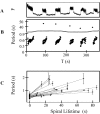Bursting calcium rotors in cultured cardiac myocyte monolayers
- PMID: 9707639
- PMCID: PMC21500
- DOI: 10.1073/pnas.95.17.10283
Bursting calcium rotors in cultured cardiac myocyte monolayers
Abstract
Rotating waves (rotors) of cellular activity were observed in nonconfluent cultures of embryonic chick heart cells by using a macroscopic imaging system that detected fluorescence from intracellular Ca2+. Unlike previous observations of rotors or spiral waves in other systems, the rotors did not persist but exhibited a repetitive pattern of spontaneous onset and offset leading to a bursting rhythm. Similar dynamics were observed in a cellular automaton model of excitable media that incorporates spontaneous initiation of activity, and a decrease of excitability as a consequence of rapid activity (fatigue). These results provide a mechanism for bursting dynamics in normal and pathological biological processes.
Figures



References
-
- Frazier W T, Kandel E C, Kupfermann I, Waziri R, Coggeshall R E. J Neurophysiol. 1967;30:1288–1351. - PubMed
-
- Canavier C C, Clark J W, Byrne J H. J Neurophysiol. 1991;66:2107–2124. - PubMed
-
- Cook D L, Satin L S, Hopkins W F. Trends Neurosci. 1991;14:411–414. - PubMed
-
- Wang X-J, Rinzel J. In: The Handbook of Brain Theory and Neural Networks. Arbib M A, editor. Cambridge, MA: MIT Press; 1995. pp. 686–691.
Publication types
MeSH terms
Substances
LinkOut - more resources
Full Text Sources
Miscellaneous

